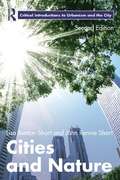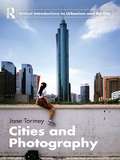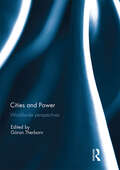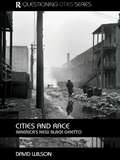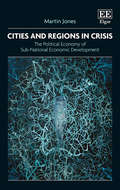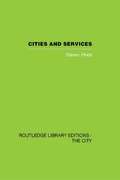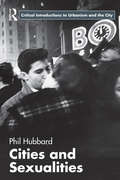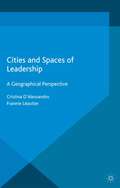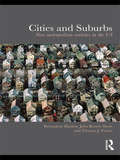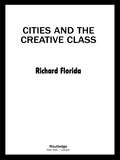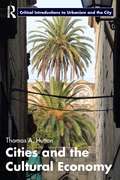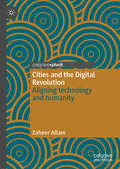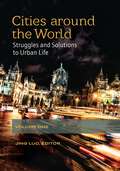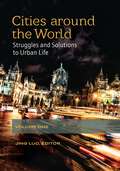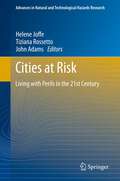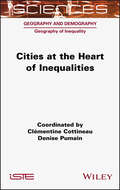- Table View
- List View
Cities and Nature (Routledge Critical Introductions to Urbanism and the City)
by Lisa Benton-Short John Rennie ShortCities and Nature connects environmental processes with social and political actions. The book reconnects science and social science to demonstrate how the city is part of the environment and how it is subject to environmental constraints and opportunities. This second edition has been extensively revised and updated with in-depth examination of theory and critical themes. Greater discussion is given to urbanization trends and megacities; the post-industrial city and global economic changes; developing cities and slums; urban political ecology; the role of the city in climate change; and sustainability. The book explores the historical relationship between cities and nature, contemporary challenges to this relationship, and attempts taken to create more sustainable cities. The historical context situates urban development and its impact on the environment, and in turn the environmental impact on people in cities. This provides a foundation from which to understand contemporary issues, such as urban political ecology, hazards and disasters, water quality and supply, air pollution and climate change. The book then considers sustainability and how it has been informed by different theoretical approaches. Issues of environmental justice and the role of gender and race are explored. The final chapter examines the ways in which cities are practicing sustainability, from light "greening" efforts such as planting trees, to more comprehensive sustainability plans that integrate the multiple dimensions of sustainability. The text contains case studies from around the globe, with many drawn from cities in the developing world, as well as reviews of recent research, updated and expanded further reading to highlight relevant films, websites and journal articles. This book is an asset to students and researchers in geography, environmental studies, urban studies and planning and sustainability.
Cities and Nature (Routledge Critical Introductions to Urbanism and the City)
by Lisa Benton-Short John Rennie ShortCities and Nature connects environmental processes with social and political actions. The book reconnects science and social science to demonstrate how the city is part of the environment and how it is subject to environmental constraints and opportunities. This second edition has been extensively revised and updated with in-depth examination of theory and critical themes. Greater discussion is given to urbanization trends and megacities; the post-industrial city and global economic changes; developing cities and slums; urban political ecology; the role of the city in climate change; and sustainability. The book explores the historical relationship between cities and nature, contemporary challenges to this relationship, and attempts taken to create more sustainable cities. The historical context situates urban development and its impact on the environment, and in turn the environmental impact on people in cities. This provides a foundation from which to understand contemporary issues, such as urban political ecology, hazards and disasters, water quality and supply, air pollution and climate change. The book then considers sustainability and how it has been informed by different theoretical approaches. Issues of environmental justice and the role of gender and race are explored. The final chapter examines the ways in which cities are practicing sustainability, from light "greening" efforts such as planting trees, to more comprehensive sustainability plans that integrate the multiple dimensions of sustainability. The text contains case studies from around the globe, with many drawn from cities in the developing world, as well as reviews of recent research, updated and expanded further reading to highlight relevant films, websites and journal articles. This book is an asset to students and researchers in geography, environmental studies, urban studies and planning and sustainability.
Cities and Photography
by Jane TormeyPhotographs display attitudes, agency and vision in the way cities are documented and imagined. Cities and Photography explores the relationship between people and the city, visualized in photographs. It provides a visually focused examination of the city and urbanism for a range of different disciplines: across the social sciences and humanities, photography and fine art. This text offers different perspectives from which to view social, political and cultural ideas about the city and urbanism, through both verbal discussion and photographic representation. It provides introductions to theoretical conceptions of the city that are useful to photographers addressing urban issues, as well as discussing themes that have preoccupied photographers and informed cultural issues central to a discussion of city. This text interprets the city as a spatial network that we inhabit on different conceptual, psychological and physical levels, and gives emphasis to how people operate within, relate to, and activate the city via construction, habitation and disruption. Cities and Photography aims to demonstrate the potential of photography as a contributor to commentary and analytical frameworks: what does photography as a medium provide for a vision of ‘city’ and what can photographs tell us about cities, histories, attitudes and ideas? This introductory text is richly illustrated with case studies and over 50 photographs, summarizing complex theory and analysis with application to specific examples. Emphasis is given to international, contemporary photographic projects to provide provide focus for the discussion of theoretical conceptions of the city through the analysis of photographic interpretation and commentary. This text will be of great appeal to those interested in Photography, Urban Studies and Human Geography.
Cities and Photography
by Jane TormeyPhotographs display attitudes, agency and vision in the way cities are documented and imagined. Cities and Photography explores the relationship between people and the city, visualized in photographs. It provides a visually focused examination of the city and urbanism for a range of different disciplines: across the social sciences and humanities, photography and fine art. This text offers different perspectives from which to view social, political and cultural ideas about the city and urbanism, through both verbal discussion and photographic representation. It provides introductions to theoretical conceptions of the city that are useful to photographers addressing urban issues, as well as discussing themes that have preoccupied photographers and informed cultural issues central to a discussion of city. This text interprets the city as a spatial network that we inhabit on different conceptual, psychological and physical levels, and gives emphasis to how people operate within, relate to, and activate the city via construction, habitation and disruption. Cities and Photography aims to demonstrate the potential of photography as a contributor to commentary and analytical frameworks: what does photography as a medium provide for a vision of ‘city’ and what can photographs tell us about cities, histories, attitudes and ideas? This introductory text is richly illustrated with case studies and over 50 photographs, summarizing complex theory and analysis with application to specific examples. Emphasis is given to international, contemporary photographic projects to provide provide focus for the discussion of theoretical conceptions of the city through the analysis of photographic interpretation and commentary. This text will be of great appeal to those interested in Photography, Urban Studies and Human Geography.
Cities and Power: Worldwide Perspectives
by Göran TherbornWhat do cities tell us about power? How does power shape cities? These are the main questions answered by a multidisciplinary set of eminent urban scholar in crisp articles on capital cities from around the world, from Buenos Aires to Tokyo, from Jakarta to Moscow. Focus is on contemporary cities and their manifestations and representations of power, though often with a historical grounding, and the collection also includes an example of archaeological urban analysis, from northern Mesopotamia. Through its variety of approaches by leading scholars of the field, and its variety of cities with their different histories and their diverse national contexts and political organization the book gives a uniquely insightful and easily accessible world overview of cities of power.This book was published as a special issue of the International Journal of Urban Sciences.
Cities and Power: Worldwide Perspectives
by Göran TherbornWhat do cities tell us about power? How does power shape cities? These are the main questions answered by a multidisciplinary set of eminent urban scholar in crisp articles on capital cities from around the world, from Buenos Aires to Tokyo, from Jakarta to Moscow. Focus is on contemporary cities and their manifestations and representations of power, though often with a historical grounding, and the collection also includes an example of archaeological urban analysis, from northern Mesopotamia. Through its variety of approaches by leading scholars of the field, and its variety of cities with their different histories and their diverse national contexts and political organization the book gives a uniquely insightful and easily accessible world overview of cities of power.This book was published as a special issue of the International Journal of Urban Sciences.
Cities and Race: America's New Black Ghetto (Questioning Cities)
by David WilsonThis fascinating book examines the 1990s rise of a new black ghetto in rust belt America, 'the global ghetto'. It uses the emergent perspective of 'racial economy' to delineate a fundamental proposition; historically neglected and marginalized black ghettos, in a 1990s era of societal boom and bust, have become more impoverished, more stigmatized, and functionally ambiguous as areas. As these ghettos grow in size and become more stigmatized entities in contemporary society, our understanding of them in relation to evolving cities and society has not kept pace. This book looks to the heart of this misunderstanding, to find out how race and political economy in cities dynamically connect in new ways ('racial economy') to deepen deprivation in these areas. This book is an essential read for students of geography, urban studies and sociology.
Cities and Race: America's New Black Ghetto (Questioning Cities)
by David WilsonThis fascinating book examines the 1990s rise of a new black ghetto in rust belt America, 'the global ghetto'. It uses the emergent perspective of 'racial economy' to delineate a fundamental proposition; historically neglected and marginalized black ghettos, in a 1990s era of societal boom and bust, have become more impoverished, more stigmatized, and functionally ambiguous as areas. As these ghettos grow in size and become more stigmatized entities in contemporary society, our understanding of them in relation to evolving cities and society has not kept pace. This book looks to the heart of this misunderstanding, to find out how race and political economy in cities dynamically connect in new ways ('racial economy') to deepen deprivation in these areas. This book is an essential read for students of geography, urban studies and sociology.
Cities and Regions in Crisis: The Political Economy of Sub-National Economic Development
by Martin JonesOffering a geographical political economy analysis, this book explores the mechanisms, institutions, and spaces of subnational economic development. Martin Jones innovatively examines how policy-makers frame problems and offer intervention solutions in different cities and regions. Drawing on different approaches to state intervention, neoliberalism, crisis and contradiction theories, and notions of depoliticisation, this book explains policy failure and how it is impacted by flux surrounding economic development. With constant changes to legislation, institutional initiatives, and ministerial responsibility, local and regional economic development is shown to be at a critical crossroads. Theoretically innovative and empirically focused, this timely book is a must-read for researchers and policy-makers of urban geography, regional development, political economy and public policy.
Cities and Services: The geography of collective consumption
by Steven PinchCaught between the twin pressures of rising public expectations and falling resources, public services have become the subject of intense academic scrutiny and public debate. Much of this controversy has been fuelled by a growing realisation that where people live has an important influence upon their access to services. The so-called 'postcode lottery.' The first part of this book considers what is meant by the term 'collective consumption' and discusses the main differences between the British and American loyal government systems. It examines various geographical schools of analysis which focus on jurisdictional partitioning, locational efficiency, externalities and locational conflict. Subsequent chapters explore the relevance of public choice, neo-Weberian and neo-Marxist theories for an understanding of collective consumption. The final section looks at ways in which spatial perspectives can be linked with broader theoretical approaches in the context of modern developments. This book was first published in it's current form in 1985.
Cities and Services: The geography of collective consumption
by Steven PinchCaught between the twin pressures of rising public expectations and falling resources, public services have become the subject of intense academic scrutiny and public debate. Much of this controversy has been fuelled by a growing realisation that where people live has an important influence upon their access to services. The so-called 'postcode lottery.' The first part of this book considers what is meant by the term 'collective consumption' and discusses the main differences between the British and American loyal government systems. It examines various geographical schools of analysis which focus on jurisdictional partitioning, locational efficiency, externalities and locational conflict. Subsequent chapters explore the relevance of public choice, neo-Weberian and neo-Marxist theories for an understanding of collective consumption. The final section looks at ways in which spatial perspectives can be linked with broader theoretical approaches in the context of modern developments. This book was first published in it's current form in 1985.
Cities and Sexualities (Routledge Critical Introductions to Urbanism and the City)
by Phil HubbardFrom the hotspots of commercial sex through to the suburbia of twitching curtains, urban life and sexualities appear inseparable. Cities are the source of our most familiar images of sexual practice, and are the spaces where new understandings of sexuality take shape. In an era of global business and tourism, cities are also the hubs around which a global sex trade is organised and where virtual sex content is obsessively produced and consumed. Detailing the relationships between sexed bodies, sexual subjectivities and forms of intimacy, Cities and Sexualities explores the role of the city in shaping our sexual lives. At the same time, it describes how the actions of urban governors, city planners, the police and judiciary combine to produce cities in which some sexual proclivities and tastes are normalised and others excluded. In so doing, it maps out the diverse sexual landscapes of the city - from spaces of courtship, coupling and cohabitation through to sites of adult entertainment, prostitution, and pornography. Considering both the normative geographies of heterosexuality and monogamy, as well as urban geographies of radical/queer sex, this book provides a unique perspective on the relationship between sex and the city. Cities and Sexualities offers a wide overview of the state-of-the-art in geographies and sociologies of sexuality, as well as an empirically-grounded account of the forms of desire that animate the erotic city. It describes the diverse sexual landscapes that characterise both the contemporary Western city as well as cities in the global South. The book features a wide range of boxed case studies as well as suggestions for further reading at the end each chapter. It will appeal to undergraduate students studying Geography, Urban Studies, Gender Studies and Sociology.
Cities and Sexualities (Routledge Critical Introductions to Urbanism and the City)
by Phil HubbardFrom the hotspots of commercial sex through to the suburbia of twitching curtains, urban life and sexualities appear inseparable. Cities are the source of our most familiar images of sexual practice, and are the spaces where new understandings of sexuality take shape. In an era of global business and tourism, cities are also the hubs around which a global sex trade is organised and where virtual sex content is obsessively produced and consumed. Detailing the relationships between sexed bodies, sexual subjectivities and forms of intimacy, Cities and Sexualities explores the role of the city in shaping our sexual lives. At the same time, it describes how the actions of urban governors, city planners, the police and judiciary combine to produce cities in which some sexual proclivities and tastes are normalised and others excluded. In so doing, it maps out the diverse sexual landscapes of the city - from spaces of courtship, coupling and cohabitation through to sites of adult entertainment, prostitution, and pornography. Considering both the normative geographies of heterosexuality and monogamy, as well as urban geographies of radical/queer sex, this book provides a unique perspective on the relationship between sex and the city. Cities and Sexualities offers a wide overview of the state-of-the-art in geographies and sociologies of sexuality, as well as an empirically-grounded account of the forms of desire that animate the erotic city. It describes the diverse sexual landscapes that characterise both the contemporary Western city as well as cities in the global South. The book features a wide range of boxed case studies as well as suggestions for further reading at the end each chapter. It will appeal to undergraduate students studying Geography, Urban Studies, Gender Studies and Sociology.
Cities and Spaces of Leadership: A Geographical Perspective (International Political Economy Ser. (PDF))
by Cristina D'Alessandro Frannie LéautierCities and Spaces of Leadership investigates the interaction between leadership, leaders and spaces at various levels. It analyzes how spaces and places influence leaders and leadership, as well as how the presence, distribution, action, and concentration of leaders in spaces contribute to their transformation.
Cities and Suburbs: New Metropolitan Realities in the US
by Bernadette Hanlon John Rennie Short Thomas J. VicinoThis book is a systematic examination of the historical and current roles that cities and suburbs play in US metropolitan areas. It explores the history of cities and suburbs, their changing dynamics with each other, their growing diversity, the environmental consequences of their development and finally the extent and nature of their decline and renewal. Cities and Suburbs: New Metropolitan Realities in the US offers a comprehensive examination of demographic and socioeconomic processes of US suburbanization by providing a succinct guide to understanding the dynamic relationship between metropolitan structure and processes of social change. A variety of case studies are used in the chapters to explore suburban successes and failures and the discourse concludes with reflections on metropolitan policy and planning for the twenty-first century. The topics of discussion include: Key ideas and concepts on the demographic and sociospatial aspects of metropolitan change The changing nature of city and suburban population migration and their relationships with changes at the local, metropolitan, national, and global levels Current metropolitan public policy issues of large cities and suburbs Links of suburbanization to metropolitan transformation and the growing dichotomy between suburban decline and suburban sprawl in metropolitan areas. Cities and Suburbs relies on theorized case studies, demographic analysis, maps, and photos from North America. Written in a clear and accessible style, the book addresses various fundamental questions about the socioeconomic role that suburbs and cities play in shaping metropolitan areas, their environmental impact, the political consequences, and the resulting policy debates. This is essential reading for scholars and students of Geography, Economics, Politics, Sociology, Urban Studies and Urban Planning.
Cities and Suburbs: New Metropolitan Realities in the US
by Bernadette Hanlon John Rennie Short Thomas J. VicinoThis book is a systematic examination of the historical and current roles that cities and suburbs play in US metropolitan areas. It explores the history of cities and suburbs, their changing dynamics with each other, their growing diversity, the environmental consequences of their development and finally the extent and nature of their decline and renewal. Cities and Suburbs: New Metropolitan Realities in the US offers a comprehensive examination of demographic and socioeconomic processes of US suburbanization by providing a succinct guide to understanding the dynamic relationship between metropolitan structure and processes of social change. A variety of case studies are used in the chapters to explore suburban successes and failures and the discourse concludes with reflections on metropolitan policy and planning for the twenty-first century. The topics of discussion include: Key ideas and concepts on the demographic and sociospatial aspects of metropolitan change The changing nature of city and suburban population migration and their relationships with changes at the local, metropolitan, national, and global levels Current metropolitan public policy issues of large cities and suburbs Links of suburbanization to metropolitan transformation and the growing dichotomy between suburban decline and suburban sprawl in metropolitan areas. Cities and Suburbs relies on theorized case studies, demographic analysis, maps, and photos from North America. Written in a clear and accessible style, the book addresses various fundamental questions about the socioeconomic role that suburbs and cities play in shaping metropolitan areas, their environmental impact, the political consequences, and the resulting policy debates. This is essential reading for scholars and students of Geography, Economics, Politics, Sociology, Urban Studies and Urban Planning.
Cities and the Creative Class
by Richard FloridaIn his compelling follow-up to The Rise of the Creative Class, Richard Florida outlines how certain cities succeed in attracting members of the 'creative class' - the millions of people who work in information-age economic sectors and in industries driven by innovation and talent.
Cities and the Creative Class (Regions And Cities Ser.)
by Richard FloridaIn his compelling follow-up to The Rise of the Creative Class, Richard Florida outlines how certain cities succeed in attracting members of the 'creative class' - the millions of people who work in information-age economic sectors and in industries driven by innovation and talent.
Cities and the Cultural Economy (Routledge Critical Introductions to Urbanism and the City)
by Thomas A. HuttonThe cultural economy forms a leading trajectory of urban development, and has emerged as a key facet of globalizing cities. Cultural industries include new media, digital arts, music and film, and the design industries and professions, as well as allied consumption and spectacle in the city. The cultural economy now represents the third-largest sector in many metropolitan cities of the West including London, Berlin, New York, San Francisco, and Melbourne, and is increasingly influential in the development of East Asian cities (Tokyo, Shanghai, Hong Kong and Singapore), as well as the mega-cities of the Global South (e.g. Mumbai, Capetown, and São Paulo). Cities and the Cultural Economy provides a critical integration of the burgeoning research and policy literatures in one of the most prominent sub-fields of contemporary urban studies. Policies for cultural economy are increasingly evident within planning, development and place-marketing programs, requiring large resource commitments, but producing – on the evidence – highly uneven results. Accordingly the volume includes a critical review of how the new cultural economy is reshaping urban labour, housing and property markets, contributing to gentrification and to ‘precarious employment’ formation, as well as to broadly favorable outcomes, such as community regeneration and urban vitality. The volume acknowledges the important growth dynamics and sustainability of key creative industries. Written primarily as a text for upper-level undergraduate and Masters students in urban, economic and social geography; sociology; cultural studies; and planning, this provocative and compelling text will also be of interest to those studying urban land economics, architecture, landscape architecture and the built environment.
Cities and the Cultural Economy (Routledge Critical Introductions to Urbanism and the City)
by Thomas A. HuttonThe cultural economy forms a leading trajectory of urban development, and has emerged as a key facet of globalizing cities. Cultural industries include new media, digital arts, music and film, and the design industries and professions, as well as allied consumption and spectacle in the city. The cultural economy now represents the third-largest sector in many metropolitan cities of the West including London, Berlin, New York, San Francisco, and Melbourne, and is increasingly influential in the development of East Asian cities (Tokyo, Shanghai, Hong Kong and Singapore), as well as the mega-cities of the Global South (e.g. Mumbai, Capetown, and São Paulo). Cities and the Cultural Economy provides a critical integration of the burgeoning research and policy literatures in one of the most prominent sub-fields of contemporary urban studies. Policies for cultural economy are increasingly evident within planning, development and place-marketing programs, requiring large resource commitments, but producing – on the evidence – highly uneven results. Accordingly the volume includes a critical review of how the new cultural economy is reshaping urban labour, housing and property markets, contributing to gentrification and to ‘precarious employment’ formation, as well as to broadly favorable outcomes, such as community regeneration and urban vitality. The volume acknowledges the important growth dynamics and sustainability of key creative industries. Written primarily as a text for upper-level undergraduate and Masters students in urban, economic and social geography; sociology; cultural studies; and planning, this provocative and compelling text will also be of interest to those studying urban land economics, architecture, landscape architecture and the built environment.
Cities and the Digital Revolution: Aligning technology and humanity
by Zaheer AllamThis book explores the emergence and development of data in cities. It exposes how Information Communication Technology (ICT) corporations seeking to capitalize on cities developing needs for urban technologies have contributed to many of the issues we are faced with today, including urbanization, centralization of wealth and climate change. Using several case studies, the book provides examples of the, in part, detrimental effects ICT driven ‘Smart City’ solutions have had and will have on the human characteristics that contribute to the identity and sense of belonging innate to many of our cities. The rise in Artificial Intelligence, Big Data, and technologies like social media, has changed how people interact with and in cities, and Allam discusses of how these changes require planners, engineers and other urban professionals to adjust their approach. The main question the book seeks to address is ‘how can we use emerging technologies to recalibrate our cities and ensure increased livability, whilst also effectively dealing with their associate challenges?’ This is an ongoing conversation, but one that requires extensive thought as it has extensive consequences. This book will be of interest to students, academics, professionals and policy makers across a broad range of subjects including urban studies, architecture and STS, geography and social policy.
Cities around the World [2 volumes]: Struggles and Solutions to Urban Life [2 volumes]
by Jing LuoThis two-volume set offers a comprehensive overview of major challenges faced by cities worldwide in the 21st century, and how cities in different geographic, economic, and political conditions are finding solutions to them.This two-volume encyclopedia examines ten critical issues that face cities across the globe today—environmental and societal struggles that affect the daily lives of city dwellers. Readers will gain a better understanding of our global neighbors and will be able to use this book in order to compare and contrast different approaches to critical issues in our world. Volume One examines employment and jobs; energy and sustainability; green spaces; housing and infrastructure; and migration and demographic changes. Volume Two discusses pollution; schools; traffic and transportation; violence, corruption, and organized crime; and waste management. Each issue begins with an introduction providing an overview of the issue from a global perspective. Following the introduction are ten alphabetically arranged world city profiles of cities that are struggling with the issue and cities that have found innovative solutions to deal with the crisis. The profiles explain how the problem came to be; consequences inhabitants face, such as compromised health, limited access to education, and high taxes with low wages; and failed and successful initiatives taken by city management.
Cities around the World [2 volumes]: Struggles and Solutions to Urban Life [2 volumes]
This two-volume set offers a comprehensive overview of major challenges faced by cities worldwide in the 21st century, and how cities in different geographic, economic, and political conditions are finding solutions to them.This two-volume encyclopedia examines ten critical issues that face cities across the globe today—environmental and societal struggles that affect the daily lives of city dwellers. Readers will gain a better understanding of our global neighbors and will be able to use this book in order to compare and contrast different approaches to critical issues in our world. Volume One examines employment and jobs; energy and sustainability; green spaces; housing and infrastructure; and migration and demographic changes. Volume Two discusses pollution; schools; traffic and transportation; violence, corruption, and organized crime; and waste management. Each issue begins with an introduction providing an overview of the issue from a global perspective. Following the introduction are ten alphabetically arranged world city profiles of cities that are struggling with the issue and cities that have found innovative solutions to deal with the crisis. The profiles explain how the problem came to be; consequences inhabitants face, such as compromised health, limited access to education, and high taxes with low wages; and failed and successful initiatives taken by city management.
Cities at Risk: Living with Perils in the 21st Century (Advances in Natural and Technological Hazards Research #33)
by Helene Joffe, Tiziana Rossetto and John AdamsWith the major growth of the world’s population over the past century, as well as rapid urbanisation, people increasingly live in crowded cities. This trend is often accompanied by proliferation of poorly built housing, uncontrolled use of land, occupation of unsafe environments and overstretched services. When a natural hazard strikes such a city many people are vulnerable to loss of life and property. This book explores what these people think and feel about the threats that they face. How do they live with perils ranging from earthquakes to monsoons, from floods to hurricanes, in the 21st century?The authors are drawn from a large range of disciplines: Psychology, Engineering, Geography, Anthropology and Urban Planning. They also reflect on how perils are represented in multiple cultures: the United States, Japan, Turkey, Bangladesh, the United Kingdom and New Zealand. The book therefore not only brings to light the ways that different cultures represent natural hazards but also the different ways in which various disciplines write about living with perils in the 21st century.The book is addressed both to researchers and to organizations involved with risk management and risk mitigation.
Cities at the Heart of Inequalities
by Clementine Cottineau Denise PumainCities have become the major habitat for human societies. They are also the places where the starkest social inequalities show up. Income, social, land and housing inequalities shape the built environment and living conditions of different neighborhoods of cities, and in return, unequal access to services, environmental quality and favorable health conditions in different neighborhoods and cities fuel the reproduction of interpersonal inequalities.This book examines how inequalities are produced and reproduced both within and between cities. In particular, we review land rent and social segregation theories from diverse disciplinary references and through examples taken from around the world. The attraction of urban centralities, which is further reinforced by the growing financialization of property and urban capital, is also analyzed through the lens of its influence on rent-seeking mechanisms and the ever increasing pressure of population migration.
